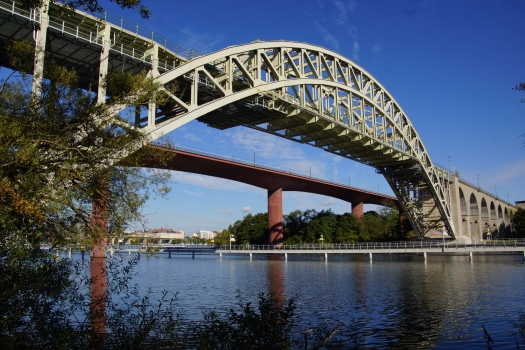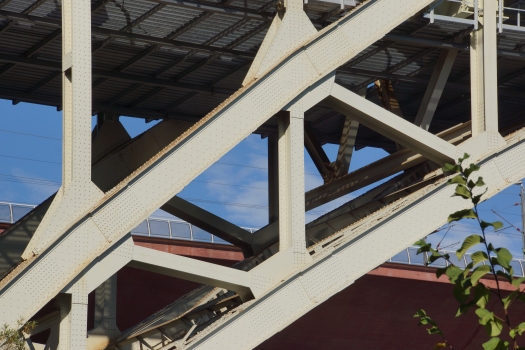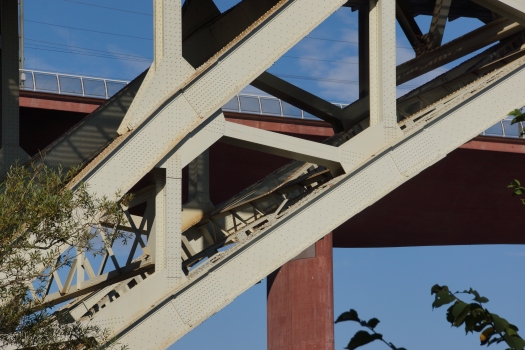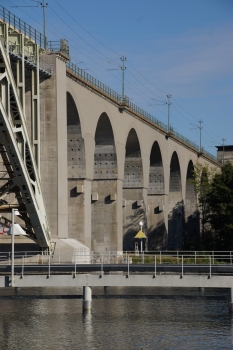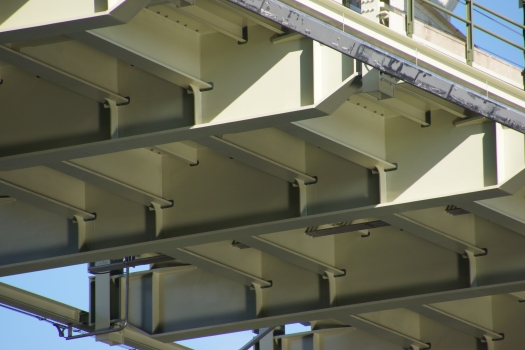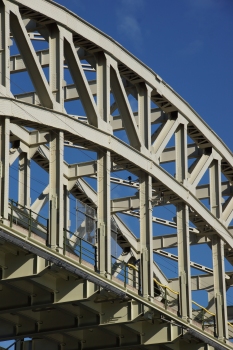General Information
Project Type
| Function / usage: |
Railroad (railway) bridge |
|---|---|
| Material: |
primary span: Steel bridge |
| Structure: |
primary span: Two-hinged arch bridge primary span: Truss arch bridge secondary span: Vertical lift bridge |
| Material: |
secondary span: Steel bridge |
| Structure: |
other spans: Vaulted arch bridge |
| Material: |
other spans: Reinforced concrete bridge |
Location
| Location: |
Stockholm, Stockholms län, Sweden |
|---|---|
| Coordinates: | 59° 18' 33" N 18° 2' 38" E |
| Coordinates: | 59° 18' 22.14" N 18° 2' 23.88" E |
Technical Information
Dimensions
| total length | 753 m | |
| number of tracks | 2 | |
| primary span | main span | 151 m |
Materials
| arch |
steel
|
|---|
Excerpt from Wikipedia
Årstabroarna (English: The Årsta bridges) are two parallel railway viaducts in central Stockholm, Sweden. Passing over the watercourse of Årstaviken and the islets Årsta holmar, they connect the major island Södermalm to the southern mainland district Årsta.
Eastern Årsta Bridge
The eastern bridge, the older of the two and still often referred to as Årstabron ("The Årsta Bridge"), is still in operation almost 80 years after ist inauguration in 1929. When projected in the early 1920s, an agreement between the state and the city stipulated the arterial railway passing through the city had to be made independent of the sea route passing beneath it. It was therefore decided that the railway should be relocated to a bridge passing over Årsta holmar, with a horizontal clearance of 26 metres ensured by a bascule bridge over the northern passage, and a truss arch bridge (The truss is the old one) over the southern passage offering a span of 100 metres.
In front of a reworked agreement in 1925, the city, intending to add an iron roadway passing above the present railway, required the bridge to be reinforced accordingly, and additionally it was decided the planned bascule bridge should be replaced by a lift bridge. The plans were carried through and the 753-metre-long (2,470 ft) bridge opened in 1929.
The bridge, on ist completion the longest bridge in Sweden, was designed be the architect Cyrillus Johansson (1884–1959) and the engineers Ernst Nilsson (1874–1946) and Salomon Kasarnowsky (1887–1960). It has often been compared to a classical Roman aqueduct, and is today declared a historical landmark.
Possible ways of adding car lanes atop the bridge were discussed on several different occasions during the remainder of the 20th century, the most elaborate plans, in 1960, being to have a motorway, called Tantoleden, connect Ringvägen and Årsta by building a new bridge on the west side of the old.
Western Årsta Bridge
A western bridge, designed by Sir Norman Foster (1935-), 833 metres long and 19,5 metres wide, was finally inaugurated in 2005. Along with the new bridge a new commuter train station, Årstaberg, was created south of the bridges. Twice the width of the old, thus permitting an elevated pathway next to the railway, the pillars of the new bridge are not only much more slender, but also reduced to ten, less than half of the old. Preceded by two decades of fiery debate, as Foster had the bridge painted in falu red, a traditional deep red colour, the bridge was nicknamed falukorven (a Swedish sausage) by ist critics.
Text imported from Wikipedia article "%C3%85rstabroarna" and modified on July 23, 2019 according to the CC-BY-SA 4.0 International license.
Participants
- Cyrillus Johansson (architect)
- Ernst Nilsson (structural engineer)
- Samuel Kasarnowsky (structural engineer)
Relevant Web Sites
Relevant Publications
- (2003): Bridging the World. Bridge Ink, Wilsonville (USA).
- (2005): Current affairs. In: Bridge Design & Engineering, v. 11, n. 41 (4th Quarter 2005), pp. 51-52.
- (2016): Upgrading of an old railway bridge – the Old Årsta Bridge. Presented at: IABSE Congress: Challenges in Design and Construction of an Innovative and Sustainable Built Environment, Stockholm, Sweden, 21-23 September 2016, pp. 645-652.
- About this
data sheet - Structure-ID
20008504 - Published on:
06/03/2003 - Last updated on:
05/11/2016

